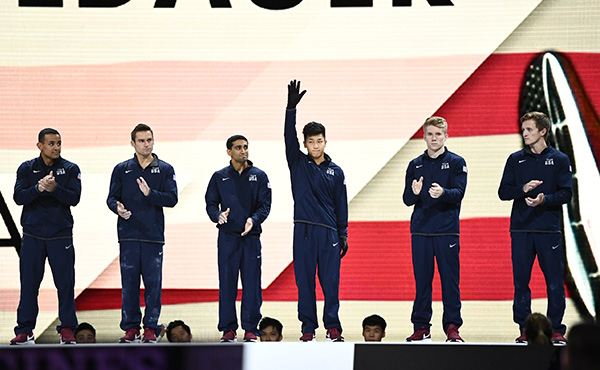
- Team Final Results
- Photo Gallery
- Routines: Sam Mikulak | Yul Moldauer
By Blythe Lawrence
STUTTGART, Germany, Oct. 9 – Success in men’s gymnastics can be measured in different ways, and for the U.S. men’s team, a fourth-place finish in a team final at the World Gymnastics Championships — especially one where they didn’t record a fall — is a win, of sorts.
The American men turned in 18 clean routines over six rotations to finish with 254.578 points Wednesday, a four-point improvement from Monday’s qualification round where they squeaked into the team final in seventh place.
Granted, it’s not the win they’d prefer, the kind that comes with a luminescent medal and recognition during a victory ceremony. But for a team still building its difficulty and consistency, it was a big step forward.
“[After qualification] a lot of people asked, what happened? What are you going to do? And I tell them, look, you don’t win medals in qualifications. You just want to get through. If you’re going to fall, fall then. Then for finals you lock in,” Yul Moldauer said. “Going out there and hitting 18 for 18, that’s something special and that’s really important to us.”
The U.S. men were locked in as they began their competition on vault, where Akash Modi, Moldauer and Mikulak set the standard, hitting near identical Tsukahara vaults with 2.5 twists and minimal errors. And the hit sets just kept on coming, with Modi leading off the U.S. on vault, pommel horse and high bar, where he turned in some of his finest work of the season, scoring 14.016.
“Honestly it was the most calm I’ve felt in a long time. I was ready. I’ve never been more ready in my life, and that was it,” Modi said. “We tried not to focus on the numbers as a team, just hit routines, and I thought we did a great job today.”
After a first day where he felt like he “never woke up,” team leader Sam Mikulak was energized and fully concentrated for the final, racking up big score after big score, leading the team on every event except vault. Altogether, Mikulak totaled 86.931 overall, an all-around score that would have put him second in the standings behind Russia’s Nikita Nagornyy had he done it in qualification.
“I just forgot about it. Never happened. I have so much good training behind me, relying on that, moving forward, knowing I’m capable, and [I was] going out and putting on a show,” Mikulak said of his off-day Monday. “We always get hyped for team finals, but I think this one, we just had a lot more trust, especially after qualifications. We wanted to just put it behind us and say, ’Hey, it’s a new day. We’re starting on vault, which is not where we planned on being, but let’s make the most of it.’ We had that underdog spot, and we just took advantage of it.”
World rookies Shane Wiskus and Trevor Howard contributed solid routines to the team effort as well. Wiskus, a junior at the University of Minnesota, chipped in a high bar routine that featured a stuck double-twisting double layout dismount and a floor exercise that featured so many stuck tumbling passes he seemed to have glue and not chalk on his feet.
“That was one of the more fun meets I’ve been a part of in awhile,” Wiskus said. “To go out error free the entire meet with a team is an incredible feat, and it just feels amazing.”
Strongman Trevor Howard, a former Penn State standout, closed the team competition on still rings. “I was just ready to go out there,” said Howard, who had a five-rotation wait before he did his routine. “I had a little more juice in the dismount than anticipated, but I was just excited to go out and compete.”
With routines bursting with well-controlled power and difficulty, the strong Russian men’s team captured its first World team title with 261.726 points, followed by 2018 champion China with 260.729 and 2016 Olympic champion Japan, whose band of lesser-seasoned newcomers tallied 258.159. Faced with the eye-popping difficulty of the top three teams, the U.S. scores weren’t comparable, but given a few more months to hone harder routines, they feel they could make up the four-point margin separating them from Japan.
“We made up four to five points in start value from 2018, so I think a combination of that and also bringing that execution score up to an 8.5 average would help us quite a bit,” said Brett McClure, the U.S. men’s high-performance director. “Obviously four points can look tremendous, but if we break it down routine by routine, with a 10th or two 10ths for each guy, if we kind of task them that on the next few months, whether it’s difficulty or execution, pick one, let’s stick to it.”
For Mikulak and Moldauer, Friday’s men’s all-around competition is a second opportunity to show what they’re capable of — and one more stepping stone toward Tokyo.
“This is just going to be something to build off of,” Mikulak said, “and it’s going to be even better next year.”




